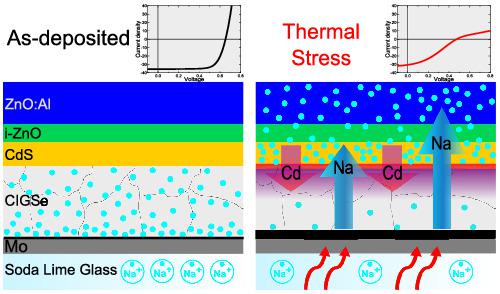当前位置:
X-MOL 学术
›
Prog. Photovoltaics
›
论文详情
Our official English website, www.x-mol.net, welcomes your
feedback! (Note: you will need to create a separate account there.)
Decay mechanisms in CdS-buffered Cu(In,Ga)Se2 thin-film solar cells after exposure to thermal stress: Understanding the role of Na
Progress in Photovoltaics ( IF 8.0 ) Pub Date : 2021-05-26 , DOI: 10.1002/pip.3438 Hasan A. Yetkin 1, 2 , Tim Kodalle 1 , Tobias Bertram 1 , Alejandra Villanueva‐Tovar 1 , Marin Rusu 3 , Reiner Klenk 1 , Bernd Szyszka 2 , Rutger Schlatmann 1, 4 , Christian A. Kaufmann 1
Progress in Photovoltaics ( IF 8.0 ) Pub Date : 2021-05-26 , DOI: 10.1002/pip.3438 Hasan A. Yetkin 1, 2 , Tim Kodalle 1 , Tobias Bertram 1 , Alejandra Villanueva‐Tovar 1 , Marin Rusu 3 , Reiner Klenk 1 , Bernd Szyszka 2 , Rutger Schlatmann 1, 4 , Christian A. Kaufmann 1
Affiliation

|
Due to their tunable bandgap energy, Cu(In,Ga)Se2 (CIGSe) thin-film solar cells are an attractive option for use as bottom devices in tandem configurations. In monolithic tandem devices, the thermal stability of the bottom device is paramount for reliable application. Ideally, it will permit the processing of a top device at the required optimum process temperature. Here, we investigate the degradation behavior of chemical bath deposited (CBD) CdS-buffered CIGSe thin-film solar cells with and without Na incorporation under thermal stress in ambient air and vacuum with the aim to gain a more detailed understanding of their degradation mechanisms. For the devices studied, we observe severe degradation after annealing at 300°C independent of the atmosphere. The electrical and compositional properties of the samples before and after a defined application of thermal stress are studied. In good agreement with literature reports, we find pronounced Cd diffusion into the CIGS absorber layer. In addition, for Na-containing samples, the observed degradation can be mainly explained by the formation of Na-induced acceptor states in the TCO front contact and a back contact barrier formation due to the out-diffusion of Na. Supported by numerical device simulation using SCAPS-1D, various possible degradation models are discussed and correlated with our findings.
中文翻译:

暴露于热应力后 CdS 缓冲的 Cu(In,Ga)Se2 薄膜太阳能电池的衰减机制:了解 Na 的作用
由于其带隙能量可调,Cu(In,Ga)Se 2(CIGSe) 薄膜太阳能电池在串联配置中用作底部器件是一个有吸引力的选择。在单片串联器件中,底部器件的热稳定性对于可靠应用至关重要。理想情况下,它将允许在所需的最佳工艺温度下加工顶部器件。在这里,我们研究了化学浴沉积 (CBD) CdS 缓冲的 CIGSe 薄膜太阳能电池在环境空气和真空中的热应力下掺入和不掺入钠的降解行为,目的是更详细地了解其降解机制。对于所研究的器件,我们观察到在 300°C 下退火后与大气无关的严重退化。研究了在规定的应用热应力之前和之后样品的电学和成分特性。与文献报道非常一致,我们发现 Cd 明显扩散到 CIGS 吸收层中。此外,对于含钠样品,观察到的降解主要可以通过在 TCO 前接触中形成 Na 诱导的受体态和由于 Na 的外扩散而形成的后接触势垒来解释。在使用 SCAPS-1D 的数值设备模拟的支持下,讨论了各种可能的退化模型并将其与我们的发现相关联。
更新日期:2021-05-26
中文翻译:

暴露于热应力后 CdS 缓冲的 Cu(In,Ga)Se2 薄膜太阳能电池的衰减机制:了解 Na 的作用
由于其带隙能量可调,Cu(In,Ga)Se 2(CIGSe) 薄膜太阳能电池在串联配置中用作底部器件是一个有吸引力的选择。在单片串联器件中,底部器件的热稳定性对于可靠应用至关重要。理想情况下,它将允许在所需的最佳工艺温度下加工顶部器件。在这里,我们研究了化学浴沉积 (CBD) CdS 缓冲的 CIGSe 薄膜太阳能电池在环境空气和真空中的热应力下掺入和不掺入钠的降解行为,目的是更详细地了解其降解机制。对于所研究的器件,我们观察到在 300°C 下退火后与大气无关的严重退化。研究了在规定的应用热应力之前和之后样品的电学和成分特性。与文献报道非常一致,我们发现 Cd 明显扩散到 CIGS 吸收层中。此外,对于含钠样品,观察到的降解主要可以通过在 TCO 前接触中形成 Na 诱导的受体态和由于 Na 的外扩散而形成的后接触势垒来解释。在使用 SCAPS-1D 的数值设备模拟的支持下,讨论了各种可能的退化模型并将其与我们的发现相关联。











































 京公网安备 11010802027423号
京公网安备 11010802027423号